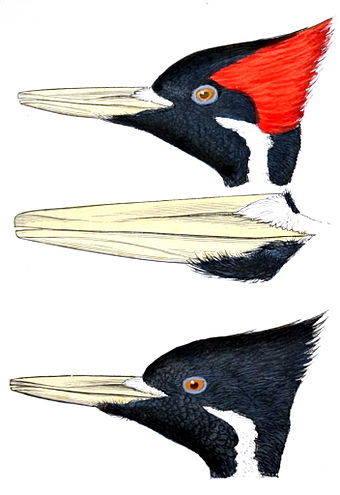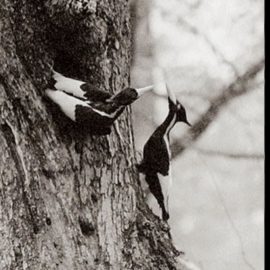
Months ago maybe a year ago there were stories on this woodpecker. Had it gone extinct or was it hiding in the woods. Some said they had made sightings but other said they were mistaken. Now a new story.
The endangered ivory-billed woodpecker, which has been seen so sparingly in the past century that the federal government dubbed it extinct, may not be wiped out after all. A group of ornithologists from Project Principalis and the National Aviary claim the woodpecker was spotted in an undisclosed Louisiana location as recently as last October, a month after the U.S. Fish and Wildlife Service said the bird should be removed from the endangered species list and considered extinct. Their study, which has not been peer-reviewed, is the result of a years-long search during which the authors claim to have seen the elusive bird dozens of times and to have captured it in multiple trail camera and drone photos. “Our findings, and the inferences drawn from them, suggest an increasingly hopeful future for the ivory-billed woodpecker,” the authors wrote.
nola.com
This woodpecker is the basis for Woody Woodpecker I grew up with. I did not know that.
With a distinct black and white plumage and ivory bill, the woodpecker has long captured the public’s attention. It was in part the inspiration for Walter Lantz’ “Woody the Woodpecker” character, which he dreamed up in 1940 after the bird supposedly disrupted his California honeymoon. But its population has dwindled since the 1930s, largely because of the destruction of its forest habitat and increased pursuit from hunters and collectors. A nationwide search in the 1930s resulted in just 22 birds spotted in Florida, South Carolina and Louisiana; in 1944, the bird was seen in Madison Parish near Tallulah. A third 2005 sighting in Central Arkansas has been widely debated, and other claimed sightings over the years have failed to meet the U.S. Fish and Wildlife Service’s evidence standards, which require submission of clear photographs, feathers or other specimens.
With the lack of sightings the Fish and Wildlife service was going to say it was extinct.
In September, the woodpecker was included in a list of 23 species that the Fish and Wildlife Service said should be considered lost. The agency held a virtual public hearing about its decision in January, but has yet to finalize it and officially remove the bird from the endangered species list. A spokesperson for the wildlife service declined to comment this week on the new study, saying the agency has yet to review it. “A final decision has not been made on the September 2021 proposal to delist the species due to extinction. We are currently reviewing information submitted and will base our final determination on the best available science,” said Vanessa Kauffman.
Project Principalis used a variety of means to find the woodpecker.
Project Principalis researchers used a variety of techniques to find the elusive woodpecker, including “slowly moving reconnaissance, sitting in place, and stakeouts of key areas, points, or cavities,” they said. Researchers said “skilled observers” spotted ivory-billed woodpeckers more than a dozen times, but failed to capture them in high-quality images. Instead, the report features images from trail cameras and drones placed strategically near trees that scientists suspected the woodpeckers had frequented. In an interview this week, Steven Latta, director of conservation and field research at the National Aviary, said those photos are grainy because they were taken from a long distance and in the early, sometimes foggy, morning when the woodpecker was most actively foraging. He said he has no doubt that the creatures captured in photos are ivory-billed woodpeckers. “We felt as scientists we had a responsibility to make this information public now,” Latta said. “The ivory-billed woodpecker is such an iconic bird, and the question of whether or not it exists has engendered strong opinions on both sides for decades,” he said, noting he hopes releasing an early version of his study would foster “respectful and informed discussion.”
Is this a case of I saw it because I wanted to see it?
In the last week, that much has proven true. John Dillon, the president of the Louisiana Ornithological Society, was hardly convinced by the new photos. “If nobody told me I was looking at a woodpecker, I’d have thought it was a limb,” he said. Dillon said the birds in the photos were likely pileated woodpeckers, birds that look very similar to the ivory-billed woodpecker but have a smaller, darker bill and a white throat. Dillon said this is the case with many of the photos he is sent by birders who claim to have spotted the rare bird. “They kind of all look like the other supposed photos that I’ve seen,” he said. “I’d love there to be irrefutable evidence, but this is not irrefutable evidence.”
They do look very similar. But maybe, just maybe, one has been found.



